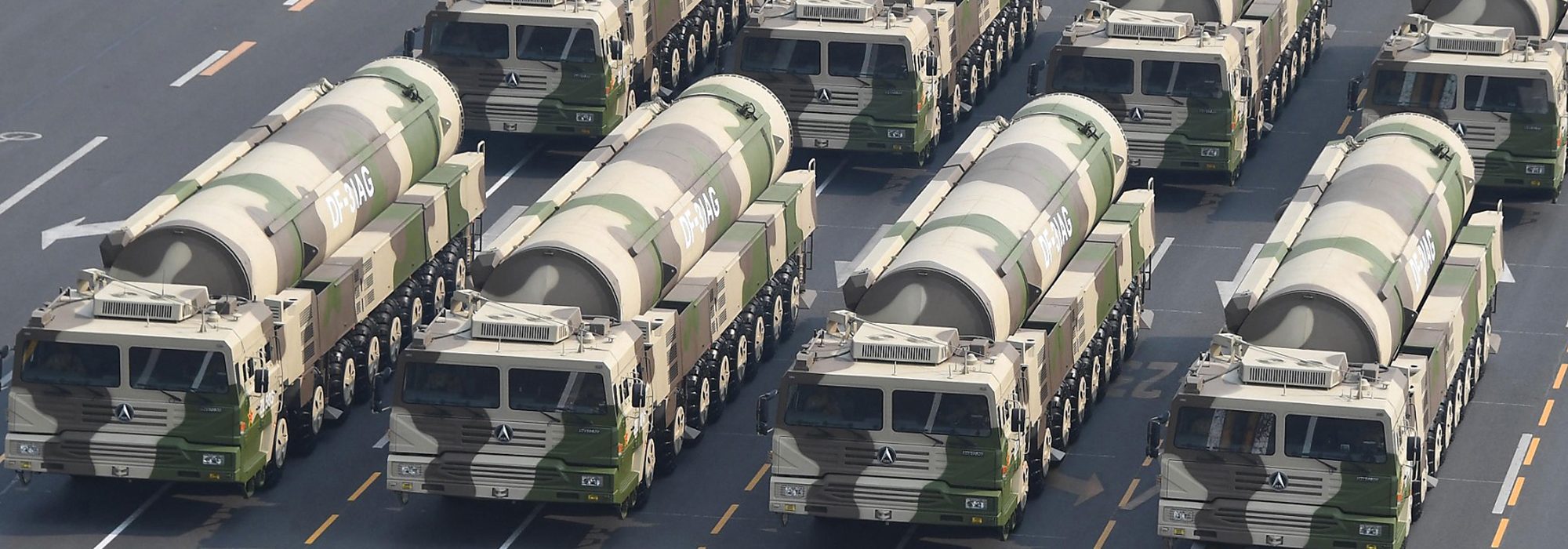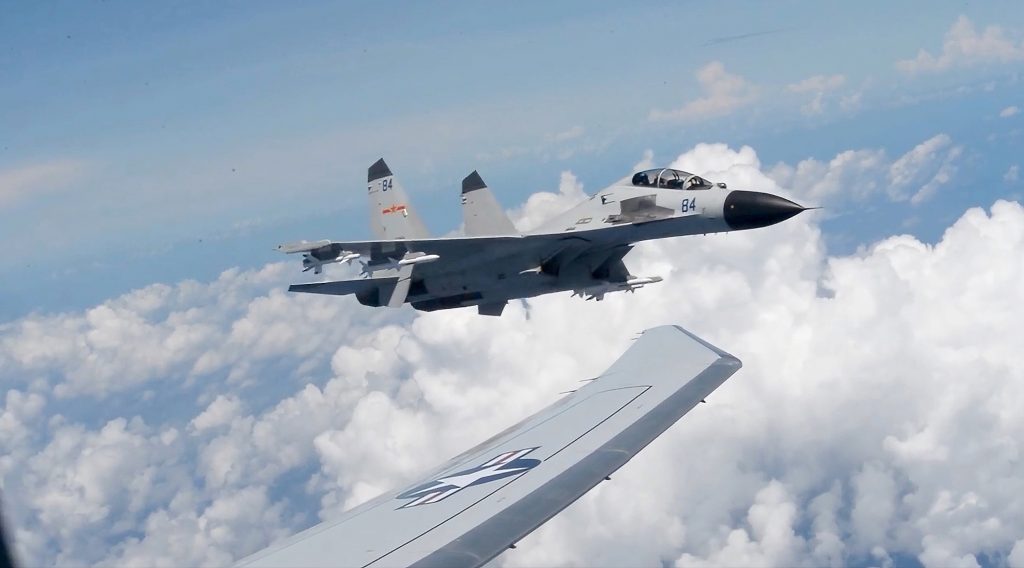By Greg Hadley
China’s military continues to expand its reach around the globe, building up strategic and tactical capabilities, especially its missile programs, according to a Pentagon report released Oct. 19.
The updated annual China Military Power Report says the People’s Liberation Army is developing:
- Air-to-air missiles that can strike from beyond visual range;
- Conventionally armed intercontinental missile systems; and
- Increased numbers of nuclear warheads.
Advances in air-to-air missile technology remain vague. The 2021 edition of the China Military Power Report cited China’s development of the PL-15 missile, a beyond-visual-range munition comparable to the U.S.’ AIM-120 AMRAAM. But the update makes no mention of the weapon. While a senior defense official declined to discuss China’s long-range air-to-air missiles in any depth during a press backgrounder, unconfirmed reports indicate China is now working on a more advanced long-range missile, perhaps dubbed PL-21, and the Pentagon report notes China is “exploring dual-mode guidance capabilities, which uses both active radar and infrared homing seekers that improve target-selection capabilities and make the missiles more resistant to countermeasures.”
Regarding surface-to-surface weapons, the senior defense official said that if China does develop a conventionally armed intercontinental missile, it would mark the end of a progression for the PLA Rocket Force, which has steadily developed short-, medium-, and long-range conventional ballistic missiles.
“It would give them a conventional capability to strike the U.S., for the first time for the PLA Rocket Force, and to threaten targets in the continental U.S. and Hawaii and Alaska,” the official noted. “And I think as we see them maybe exploring the development of those conventionally armed ICBMs, it raises some questions about risks to strategic stability.”
Meanwhile, China continues to rapidly expand its nuclear forces. China “probably completed the construction of its three new solid-propellant silo fields in 2022, … [with] at least 300 new ICBM silos, and has loaded at least some ICBMs into these silos,” the report states, estimating that China “possessed more than 500 operational nuclear warheads as of May 2023,” up from 400 a year ago.
China’s nuclear force remains small in comparison to the U.S. (about 5,200 warheads) and Russia (nearly 5,900), according to the Federation of American Scientists, but the rapid growth shows China’s ambition. “We see the PRC continuing to quite rapidly modernize and diversify and expand its nuclear forces,” the senior defense official said. “They’re expanding and investing in their land-, sea-, and air-based nuclear delivery platforms, as well as the infrastructure that’s required to support this quite major expansion of their nuclear forces.”
Meanwhile, China continues to update the People’s Liberation Army Air Force, with the goal “to become a truly ‘strategic’ air force, able to project power at long distances to advance and defend the PRC’s global interests.” The PLAAF “is rapidly catching up to western air forces,” the report concludes, with key programs including:
- Upgrades to its fifth-generation J-20 fighter;
- Developing its H-20 bomber, projected to have both nuclear and conventional roles;
- “New medium- and long-range stealth bombers to strike regional and global targets;” and
- The new Y-20U tanker.
“These new air refuelable aircraft will significantly expand the PRC’s ability to conduct long-range offensive air operations,” the report states. “In addition to aerial refueling, it is expected that there will likely be further Y-20 variants, such as a possible [airborne early warning and control] variant.”
Pentagon Declassifies More Dangerous Chinese Intercepts
By Chris Gordon
Chinese aircraft have engaged in many more risky intercepts of U.S. planes over the past two years than was previously publicly known, with more than 180 dangerous incidents over the South and East China Seas, according to newly declassified information released by the Pentagon. That is more than the previous decade combined.
The incidents are part of a “centralized and concerted campaign to perform these risky behaviors in order to coerce a change in lawful U.S. operational activity and that of U.S. allies and partners,” said Ely Ratner, the assistant secretary of defense for Indo-Pacific security affairs.
One January incident, highlighted during the Pentagon briefing, showed a U.S. plane flying above the South China Sea when a Chinese fighter jet armed with missiles closed within 30 feet and flew alongside for around 15 minutes.
That came just one month after a Chinese a J-11 flew within 20 feet of an RC-135 over the South China Sea. In other instances, Chinese fighters came within 10 feet of U.S. aircraft and discharged chaff and flares.
The newly released footage comes as talks between the U.S. and the People’s Liberation Army (PLA) have stalled at both the uniformed and civilian levels. Both Ratner and Adm. John C. Aquilino, commander of U.S. Indo-Pacific Command (INDOPACOM), have had isolated conversations with Chinese officials, but no substantive dialogue is taking place.
“I’ve asked to speak with my counterparts, the Eastern and Southern Theater commanders, now going on two and a half years,” Aquilino said. “I have yet to have one of those requests accepted.”
The newly declassified images were released ahead of the annual congressionally mandated China Military Power Report, which will highlight the rise in incidents, according to U.S. officials.
Images and video newly released by the Department show a PLA Air Forces fighter jet conducting a coercive and risky intercept against a lawfully operating U.S. asset in the East China Sea. The PLA fighter jet first sped toward the U.S. aircraft, then crossed under the plane’s nose, causing it to lose visual contact with the PLA fighter. Later, the U.S. pilot opened the distance between the two planes, but the PLA pilot re-approached coming within 10 to 15 feet.
In addition to incidents with U.S. aircraft, the Pentagon said there had been dozens more involving U.S. allies and partners, for a total of 300 dangerous incidents since 2021.
Looming in the background is the possibility such encounters could turn deadly, even if China’s armed aircraft have no plan of intentionally downing a U.S. plane.
“People’s lives are at risk,” Aquilino said. “One accident is too many. We went through it in 2001.”
That’s when a Chinese fighter collided with a U.S. Navy spy plane, killing the Chinese pilot and forcing the American plane to make an emergency landing in China. The American crew was temporarily detained while Chinese officials dismantled the U.S. aircraft.
In a June incident, a Chinese fighter approached within 40 feet of an American surveillance plane and “flashed its weapons,” which are visible in a video released by the U.S. “After the U.S. operator radioed the PLA fighter jet, the PLA pilot responded using explicit language, including an expletive,” the Pentagon said.
China’s territorial claims are expansive and go beyond international norms. China, for instance, claims most of the South China Sea and the airspace above it as its own. The U.S. and international authorities disagree.
“U.S. planes are operating safely, responsibly, and in accordance with international law,” Ratner said. “Indeed, the skill and professionalism of American service members should not be the only thing standing between PLA fighter pilots and a dangerous, even fatal, accident.”

